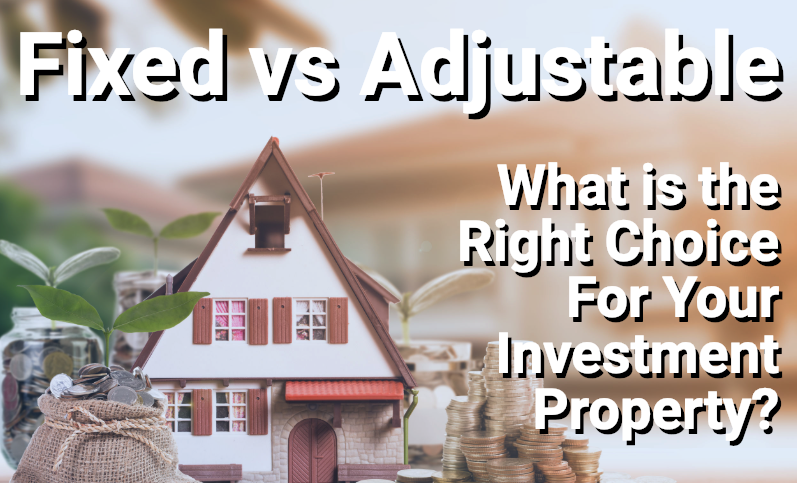Purchasing an investment property is one of the most exciting times in your life, but if you choose the wrong mortgage for your needs, your purchase could be more of a burden than a blessing.
Before you can think about refurbishments, marketing, and leases, you need to think about financing. By choosing the right mortgage, you’ll experience better profitability and long-term financial gains, and one of the decisions you need to make is whether you will use a fixed-rate or adjustable-rate mortgage.
With 30-year mortgages for investment properties, we offer both fixed and adjustable mortgage. Each type has its advantages, so let’s go over each one so you understand the right choice for your needs.
30-Year Investment Property Mortgages: Fixed or Adjustable Rate?
Advantage of a 30-Year Fixed-Rate Investment Property Mortgage
As the name suggests, a fixed-rate mortgage allows you to have an interest rate that remains the same throughout the entire life of the loan. While the percentage of the payment that goes towards the interest and towards the balance will change, the exact amount you pay will never vary.
The main advantage of having a fixed-rate on your 30-year mortgage is that the monthly payments will remain the same no matter what is happening in the market. Whether rates go up or down, your mortgage payment remains the same, which adds predictability and consistency to your investment strategy. With fixed-rate mortgages, you’ll also have an easier time understanding and comparing the differences in loan products, which can help you choose the right one for your needs.
With a fixed-rate mortgage on your investment property, you are protected from the potential increases in interest rates, providing greater stability to your investment plan. They are easy to understand, and sometimes simplicity is an underrated factor in real estate investing. Having a fixed-rate on your investment property loan can provide enhanced peace of mind and less concern about your investment portfolio because you won’t have to worry about increases in interest rates, or try to work out the math on a loan that has an increased rate.
The downside to a fixed-rate loan is that you don’t get to take advantage of the potential drops in interest rates. You can always refinance a fixed-rate mortgage, but with adjustable-rate mortgages, you basically get an automatic drop in payments if interest rates go down. (But you also get an automatic rise if interest rates climb.)
Advantage of a 30-Year Adjustable-Rate Investment Property Mortgage
With an adjustable-rate mortgage, you have a loan that can change interest rates periodically, which can be either a good or a bad thing for your investment strategy. For most ARM loans, you will have a period, which lasts roughly three to ten years depending in the loan, when the interest rate is locked. When the period ends, your interest rate is adjusted to reflect current standards, which means your monthly payments could go up or down at that point. ARM loans for investment properties are usually adjusted every year.

The advantage of having an adjustable rate mortgage is that you stand to take advantage of lower interest rates that might come in the future. If rates drop, you will see a lower monthly payment on your investment-property loan. With a fixed-rate loan, you would have to go through the laborious and potentially costly process of refinancing to take advantage of lower interest rates. However, if the rates rise, your loan payments will rise as well, which is the potential downside to adjustable-rate loans.
With an adjustable-rate mortgage, you have the chance to get lower interest rates for the initial period. This is because ARM loans have less risk to the lender, as the borrower takes on the interest-rate adjustments. Because you, as the borrower, take on some of the risk, you may be rewarded with a lower interest rate compared to a fixed-rate loan, at least for the initial period. This is one of the advantages, and you can refinance once the initial period is over, although this may not always be a profitable strategy, considering loan origination costs and fees.
Excellent 30-Year Investment Property Mortgages from SDPL
Working with our experienced team, you can use a fixed or adjustable-rate mortgage to purchase a new investment property for your portfolio. However, you can also use the mortgage option to refinance a current loan, which can help you get more-affordable terms or a lower interest rate. The loans can also be used for cash-out refinancing, which allows you to take advantage of equity you already have in an investment property.
If you use a loan for up to 70% of the value of the property, you can get financing up to $1.5 million. However, we understand that many properties, especially properties in the San Diego area, can go well beyond that price. With that in mind, we also offer up to $3 million in investment-property financing if the loan-to-value ratio is 60% or less.
With this loan option, you’ll be able to take advantage of a simple loan-qualification process. This can be important when you want to move quickly on an investment property before it goes to another buyer. For self-employed individuals, we simply need to confirm your income over the past two years (among other information not tied to income), as well as the nature of your business and your year-to-date income. If you are a wage earner, we just need to see a letter from your employer stating the employment history, and position, the monthly salary, and paystubs, as well as year-to-date earnings.
If you want to learn more about top-quality loans from San Diego Purchase Loans, contact our helpful staff today. We’ll make sure you have the right information to make a fully-informed decision on your mortgage.
From fixed-rate investment-property mortgages to ARM loans for your primary residence, we can help you create a strong foundation through real estate property.


